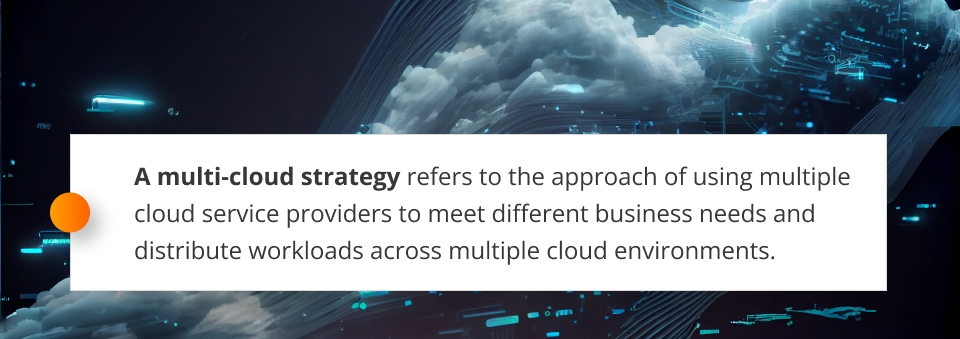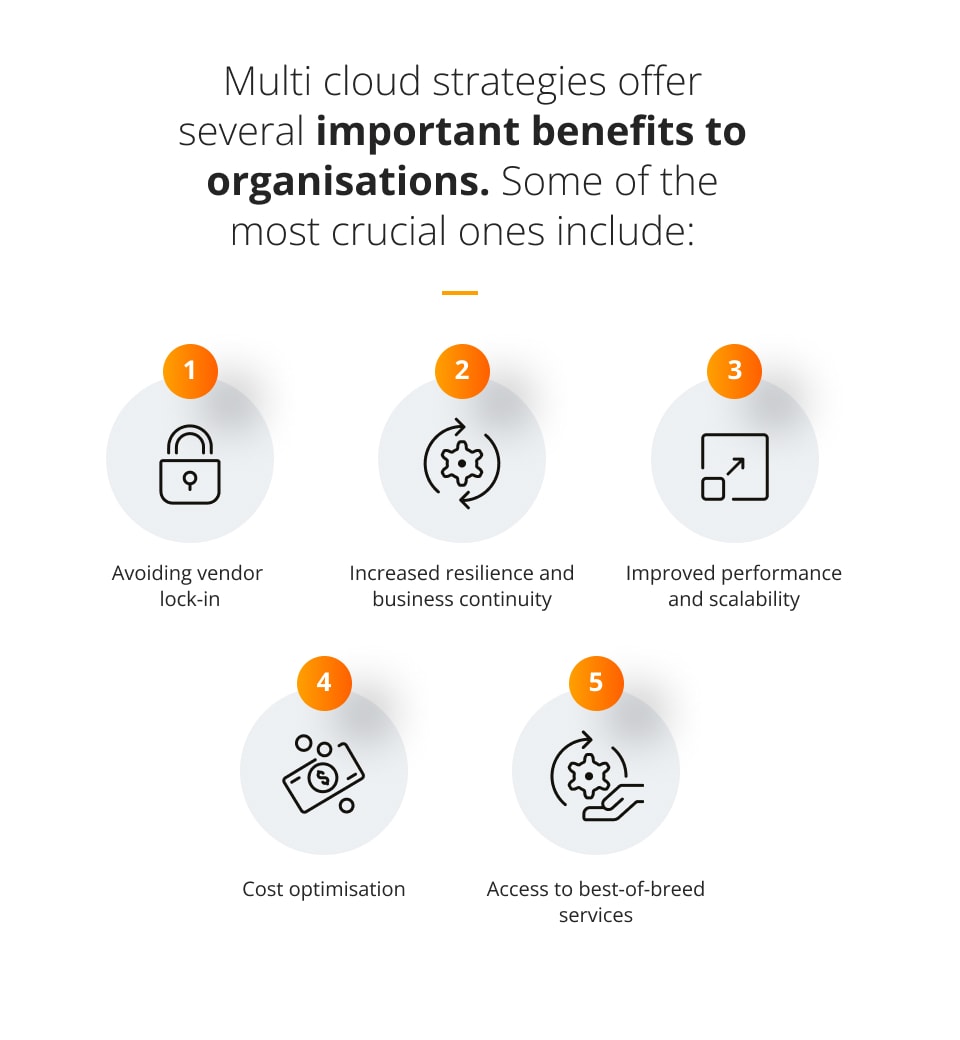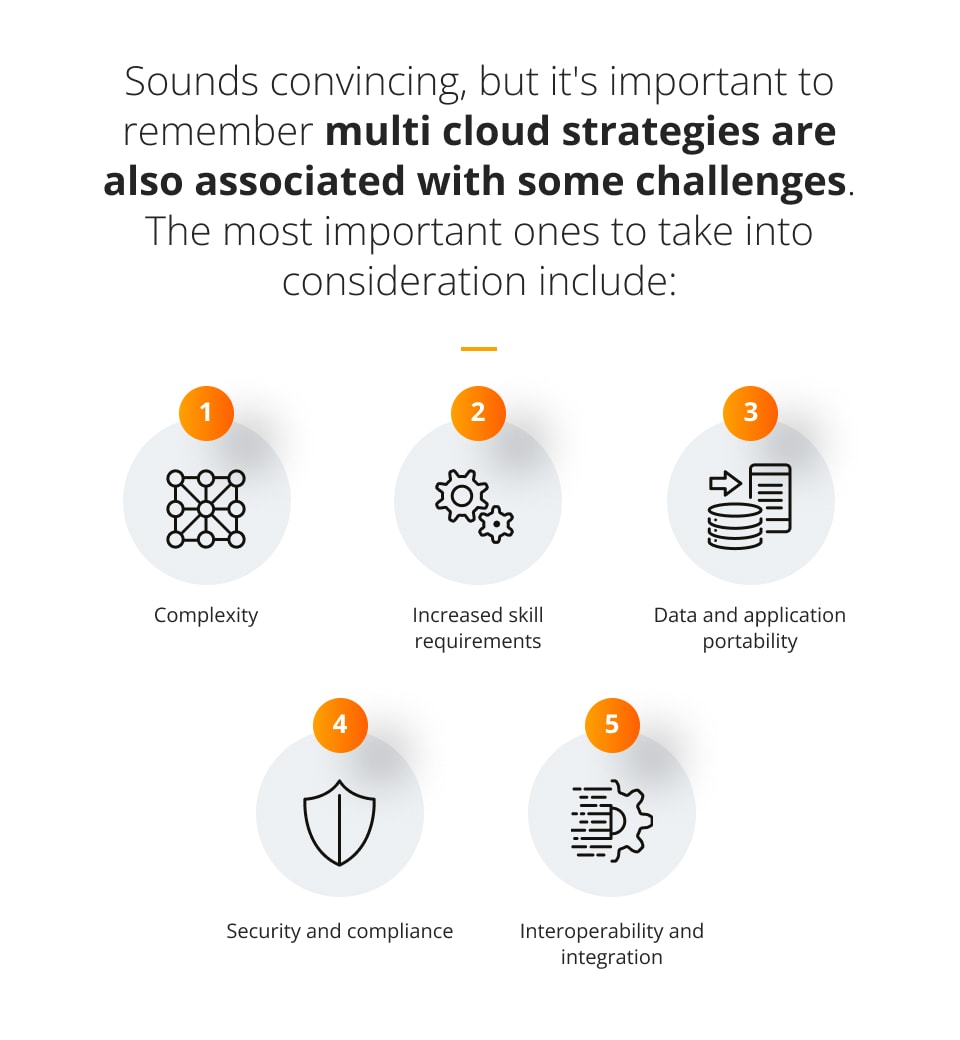
Multi-cloud strategy that fits your needs
Although the cloud world is dominated by big names such as Amazon Web Services or Azure, there are many other cloud providers that offer several benefits and can have a positive impact on your organisation. Great news is, you don't need to choose just one – welcome to the multi-cloud strategy!
What is a multi-cloud strategy?
Before we dive into tangible benefits and challenges of such an approach, let’s look at what a multi-cloud strategy is.
Rather than relying on a single cloud provider, organisations adopt multi-cloud strategies to leverage the strengths and unique features of multiple cloud platforms and to avoid vendor lock-in.
Looking at it from a more practical point of view, in a multi-cloud strategy, an organisation may use different cloud providers simultaneously, such as Amazon Web Services (AWS), Microsoft Azure, Google Cloud Platform (GCP), or others, each offering a distinct set of services, capabilities, pricing models, and geographic regions, allowing businesses to choose the most suitable multi-cloud computing for specific workloads or applications.
Why is a multi-cloud strategy important?
There are several reasons for why a multi-cloud strategy is important. By using it organisations can avoid being locked into a single cloud provider, which reduces their dependency on a single vendor and provides flexibility to choose the best services, pricing models and features from multiple clouds. Such an approach empowers businesses to make strategic decisions based on their specific needs rather than being limited by the offerings of a single vendor.
The benefits and challenges of a multi-cloud approach
Multi-cloud strategies offer several important benefits to organisations. Some of the most crucial ones include:
Avoiding vendor lock-in
Multi-cloud strategies prevent dependency on a single cloud provider, offering flexibility and the ability to choose the best services from multiple vendors.
Increased resilience and business continuity
Distributing workloads across multiple cloud providers reduces the risk of service disruptions or outages, ensuring business continuity.
Improved performance and scalability
Leveraging different cloud providers’ strengths and capabilities allows for optimal performance and scalability, as workloads can be placed where they perform best.
Cost optimisation
Multi-cloud enables organisations to optimise costs by selecting the most cost-effective services from different providers and taking advantage of competitive pricing.
Access to best-of-breed services
Different cloud providers excel in specific areas, and a multi-cloud approach allows businesses to leverage the best services and features from each provider.
Sounds convincing, but it’s important to remember multi-cloud strategies are also associated with some challenges. The most important ones to take into consideration include:
Complexity
Managing multiple cloud environments requires additional complexity in terms of architecture, integration, security, and governance.
Increased skill requirements
IT teams need to have expertise in managing and integrating multiple cloud platforms, which may require additional training and resources.
Data and application portability
Ensuring seamless data and application portability across multiple cloud providers can be challenging, requiring careful planning and implementation.
Security and compliance
Managing security and compliance across multiple cloud environments requires consistent policies and monitoring practices to ensure data protection and regulatory compliance.
Interoperability and integration
Ensuring smooth interoperability and integration between different cloud platforms can be complex, especially if there are differences in standards and APIs.
If you are considering using multiple cloud services, take time to carefully evaluate the benefits and challenges, weigh them against your specific needs, and develop a well-defined strategy and governance framework to effectively manage the complexities involved.
Developing a multi-cloud strategy that fits your business needs
Developing a multi-cloud strategy that fits your business needs involves careful planning and consideration of various factors. Here are some steps to help you create a tailored multi-cloud strategy:
1. Identify business objectives
Clearly define your business objectives and how cloud computing aligns with them. Understand the specific needs and requirements of your organisation, such as scalability, performance, compliance, or cost optimisation.
2. Assess workloads and requirements
Evaluate your existing workloads and determine which ones are suitable for the cloud. Consider factors like data sensitivity, performance requirements, integration complexity, and regulatory compliance. Categorise workloads based on their characteristics and suitability for different cloud platforms.
3. Select cloud providers
Research and compare different cloud providers based on their offerings, capabilities, pricing models, security measures, support, and geographic coverage. Choose providers that align with your business needs and offer the services and features required for your workloads.
4. Define governance and security policies
Establish governance policies to ensure consistency, security, and compliance across all cloud platforms. Define access controls, data protection measures, and monitoring practices. Consider implementing cloud management tools to centralise control and streamline operations.
5. Architect for portability and interoperability
Design your applications and infrastructure with portability and interoperability in mind. Use standard APIs, containerisation technologies, and abstraction layers to ensure seamless migration and interoperability between different cloud platforms. Avoid cloud provider-specific features that may create vendor lock-in.
6. Implement data management strategies
Define data management strategies that align with your multi-cloud environment. Consider data storage, backup, recovery, and synchronisation mechanisms across different providers. Ensure compliance with data privacy regulations and implement encryption and data protection measures.
7. Establish cost management practices
Develop cost management practices to optimise your multi-cloud expenses. Regularly monitor and analyse your usage to identify cost-saving opportunities. Leverage cost management tools provided by the cloud providers and consider reserved instances or spot instances to optimise costs.
8. Continuously monitor and optimise
Regularly review and assess your multi-cloud strategy to ensure it aligns with changing business needs and technology advancements. Monitor performance, security, and compliance metrics to identify areas for improvement. Seek feedback from stakeholders and make adjustments as necessary.
9. Leverage cloud management solutions
Consider using cloud management solutions or cloud service brokers that provide centralised management, monitoring, and optimisation capabilities across multiple cloud providers. These tools can help streamline operations and simplify the management of a multi-cloud environment.
10. Plan for disaster recovery and business continuity
Develop robust disaster recovery and business continuity plans for your multiple cloud environments. Ensure that critical workloads are replicated across different cloud platforms and have backup and recovery mechanisms in place to minimise downtime and data loss.
The future of multi-cloud and its potential impact on businesses
The future of multi-cloud holds significant potential for businesses. Its impact should be considered in the areas such as increased flexibility and agility, enhanced resilience and business continuity, optimised performance and scalability, vendor independence, innovation and technology adoption, integration and interoperability, as well as in industry specific solutions and services.
As the cloud landscape continues to evolve, businesses that embrace and effectively manage multi-cloud environments will be well-positioned to harness the full potential of cloud computing, drive digital transformation, and achieve their strategic objectives.
If you are keen to learn more about multiple cloud providers or are curious whether a multi-cloud strategy is best for you, do not hesitate to get in touch. We will be happy to assist you on every stage of your cloud computing journey.







